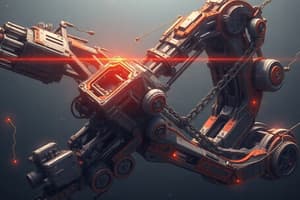Podcast
Questions and Answers
The study of motion in mechanisms without reference to the forces that cause the motion is called ______.
The study of motion in mechanisms without reference to the forces that cause the motion is called ______.
kinematics
A rigid body having two or more pairing elements which connect it to other bodies for the purpose of transmitting force or motion is known as a ______.
A rigid body having two or more pairing elements which connect it to other bodies for the purpose of transmitting force or motion is known as a ______.
link
A ______ connection between links that allows some motion between the connected links.
A ______ connection between links that allows some motion between the connected links.
joint
A kinematic pair with surface contact (when deformation is neglected) is known as a ______.
A kinematic pair with surface contact (when deformation is neglected) is known as a ______.
The number of independent inputs needed to precisely position all links of a mechanism relative to the ground is known as the ______.
The number of independent inputs needed to precisely position all links of a mechanism relative to the ground is known as the ______.
A four-bar linkage in which the shortest link can fully rotate is called a ______.
A four-bar linkage in which the shortest link can fully rotate is called a ______.
The angle between the coupler and the follower in a four-bar linkage is referred to as the ______.
The angle between the coupler and the follower in a four-bar linkage is referred to as the ______.
In a slider-crank mechanism, the positions where the crank and connecting rod are collinear are known as the ______.
In a slider-crank mechanism, the positions where the crank and connecting rod are collinear are known as the ______.
The condition $L_{max} + L_{min} <= L_a + L_b$ for a four-bar linkage is known as ______.
The condition $L_{max} + L_{min} <= L_a + L_b$ for a four-bar linkage is known as ______.
A mechanism designed to produce a slow working stroke and a quick return stroke is called a ______.
A mechanism designed to produce a slow working stroke and a quick return stroke is called a ______.
The combination of kinematics and kinetics, which studies the motion of bodies under the action of forces, is called ______.
The combination of kinematics and kinetics, which studies the motion of bodies under the action of forces, is called ______.
A joint that allows only relative rotation between two links is known as a ______.
A joint that allows only relative rotation between two links is known as a ______.
A joint that allows only relative sliding motion between two links is known as a ______.
A joint that allows only relative sliding motion between two links is known as a ______.
A kinematic pair that permits both rotation and sliding, independently, is called a ______.
A kinematic pair that permits both rotation and sliding, independently, is called a ______.
A ______ is a kinematic chain in which one link is fixed.
A ______ is a kinematic chain in which one link is fixed.
The fixed or stationary link in a mechanism is called the ______.
The fixed or stationary link in a mechanism is called the ______.
A combination of two revoluté joints that allows two angular rotations is called a ______.
A combination of two revoluté joints that allows two angular rotations is called a ______.
A linkage where each link is connected to at least two other links is called a ______.
A linkage where each link is connected to at least two other links is called a ______.
A linkage with one or more links connected to only one other link is called an ______.
A linkage with one or more links connected to only one other link is called an ______.
Machines or linkages designed to simulate human arm and hand motions are called ______.
Machines or linkages designed to simulate human arm and hand motions are called ______.
A connection between two links that allows only relative rotation is known as a ______.
A connection between two links that allows only relative rotation is known as a ______.
A kinematic pair that permits both angular rotation and independent sliding motion is called a ______.
A kinematic pair that permits both angular rotation and independent sliding motion is called a ______.
A ______ joint allows rotation about three axes.
A ______ joint allows rotation about three axes.
A ______ is a higher pair joint with rolling and sliding contact.
A ______ is a higher pair joint with rolling and sliding contact.
The idealization that assumes machine components do not deflect under load is known as a ______.
The idealization that assumes machine components do not deflect under load is known as a ______.
A combination of links and joints that provides a controlled output motion in response to an input motion is called a ______.
A combination of links and joints that provides a controlled output motion in response to an input motion is called a ______.
A linkage in which the motion of all links occurs in parallel planes is known as a ______.
A linkage in which the motion of all links occurs in parallel planes is known as a ______.
The time it takes for a mechanism to return to its original configuration after completing all its motions is called the ______.
The time it takes for a mechanism to return to its original configuration after completing all its motions is called the ______.
A combination of bodies connected by joints, but designed to support loads rather than transmit motion, is called a ______.
A combination of bodies connected by joints, but designed to support loads rather than transmit motion, is called a ______.
A Grashof four-bar mechanism where the shortest link is the frame, and both cranks fully rotate, is called a ______.
A Grashof four-bar mechanism where the shortest link is the frame, and both cranks fully rotate, is called a ______.
A Grashof mechanism where no link can fully rotate is called a ______.
A Grashof mechanism where no link can fully rotate is called a ______.
A non-Grashof four-bar linkage where no link can fully rotate is called a ______.
A non-Grashof four-bar linkage where no link can fully rotate is called a ______.
A simple machine that consists of a rigid beam pivoted about a fixed point is called a ______.
A simple machine that consists of a rigid beam pivoted about a fixed point is called a ______.
The study of forces and torques on systems at rest or in equilibrium is called ______.
The study of forces and torques on systems at rest or in equilibrium is called ______.
Flashcards
Kinematics
Kinematics
The study of motion in mechanisms without considering the forces causing it.
Link
Link
A rigid body with two or more elements connecting it to other bodies for transmitting force or motion.
Joint/Kinematic Pair
Joint/Kinematic Pair
A connection between links allowing relative motion.
Lower Pair
Lower Pair
Signup and view all the flashcards
Degrees of Freedom/Mobility
Degrees of Freedom/Mobility
Signup and view all the flashcards
Grashof Mechanism
Grashof Mechanism
Signup and view all the flashcards
Transmission Angle
Transmission Angle
Signup and view all the flashcards
Limiting Positions/Dead Centers
Limiting Positions/Dead Centers
Signup and view all the flashcards
Quick Return Mechanism
Quick Return Mechanism
Signup and view all the flashcards
Dynamics
Dynamics
Signup and view all the flashcards
Revolute/Pin Joint
Revolute/Pin Joint
Signup and view all the flashcards
Prismatic Joint
Prismatic Joint
Signup and view all the flashcards
Cylindrical Pair
Cylindrical Pair
Signup and view all the flashcards
Mechanism
Mechanism
Signup and view all the flashcards
Frame
Frame
Signup and view all the flashcards
Universal Joint
Universal Joint
Signup and view all the flashcards
Closed Loop Kinematic Chain
Closed Loop Kinematic Chain
Signup and view all the flashcards
Open Loop Kinematic Chain
Open Loop Kinematic Chain
Signup and view all the flashcards
Manipulators
Manipulators
Signup and view all the flashcards
Revolute/Pin Joint
Revolute/Pin Joint
Signup and view all the flashcards
Cylindrical Pair
Cylindrical Pair
Signup and view all the flashcards
Globular/Spherical Joint
Globular/Spherical Joint
Signup and view all the flashcards
Universal Joint
Universal Joint
Signup and view all the flashcards
Gear/Cam
Gear/Cam
Signup and view all the flashcards
Rigid Link
Rigid Link
Signup and view all the flashcards
Kinematic Chain/Linkage
Kinematic Chain/Linkage
Signup and view all the flashcards
Planar Linkage
Planar Linkage
Signup and view all the flashcards
Period
Period
Signup and view all the flashcards
Structure
Structure
Signup and view all the flashcards
Drag-Link Mechanism
Drag-Link Mechanism
Signup and view all the flashcards
Double Rocker Mechanism
Double Rocker Mechanism
Signup and view all the flashcards
Triple Rocker Mechanism
Triple Rocker Mechanism
Signup and view all the flashcards
Study Notes
Machine Elements - Midterm Exam
- Kinematics: The study of motion without considering the forces causing it.
- Link: A rigid body with two or more connections to other bodies, used to transmit force or motion.
- Kinematic Pair/Joint: A connection between links allowing some motion.
- Lower Pair: Kinematic pair with surface contact (no deformation).
- Degree of Freedom/Mobility: The number of independent inputs needed to position all links of a mechanism.
- Four-Bar Linkage: A closed-loop mechanism with four links.
- Grashof Mechanism: A four-bar linkage where the shortest link can fully rotate.
- Grashof Law/Criterion: The condition Lmax + Lmin <= La + Lb for a four-bar linkage.
- Double Rocker Mechanism: A Grashof mechanism where no link can fully rotate.
- Triple Rocker Mechanism: A non-Grashof four-bar linkage where no link can fully rotate.
- Lever: A simple machine consisting of a rigid beam pivoted about a fixed point.
- Statics: The study of forces and torques on systems at rest or in equilibrium.
- Quick Return Mechanism: A mechanism designed for a slow working stroke and a quick return stroke.
- Dynamics: The combination of kinematics and kinetics, studying motion under forces.
- Revolute/Pin Joint: A joint allowing only relative rotation.
- Prismatic Joint: A joint allowing only relative sliding motion.
- Cylindrical Pair: A kinematic pair allowing both rotation and sliding, independently.
- Mechanism: A kinematic chain with one fixed link.
- Frame: The fixed or stationary link in a mechanism.
- Universal Joint: A combination of two revolute joints allowing two angular rotations.
- Closed Loop Kinematic Chain: A linkage where each link is connected to at least two other links.
- Open Loop Kinematic Chain: A linkage where each link is connected to only one other link.
- Manipulators: Machines or linkages designed to simulate human arm and hand motions.
- Gear/Cam: A higher pair joint with rolling and sliding contact.
- Kinematic Chain/Linkage: A combination of links and joints that controls output motion from input motion.
- Planar Linkage: A linkage where the motion of all links occurs in parallel planes.
- Period (Mechanism): The time it takes for a mechanism to return to its original configuration.
Problem-Specific Results (from provided images)
-
Various problems ask for determining the total number of links (L) and joints (J) in different mechanical systems. Results vary significantly. Individual problem numbers correlate with the diagram in each case.
-
Other problems are related to finding the dimensions (lengths, heights, angles) of parts in various mechanisms based on given parameters. Again, different values for each unique problem.
Studying That Suits You
Use AI to generate personalized quizzes and flashcards to suit your learning preferences.




